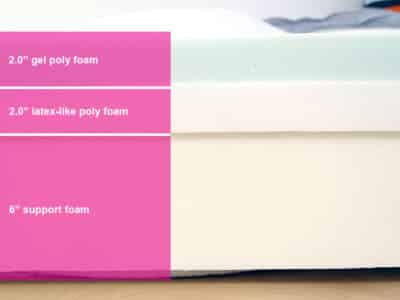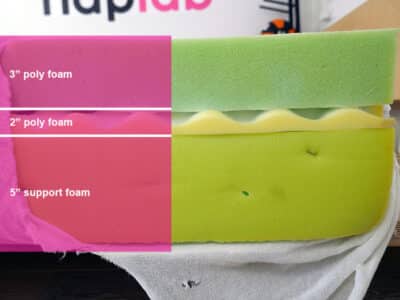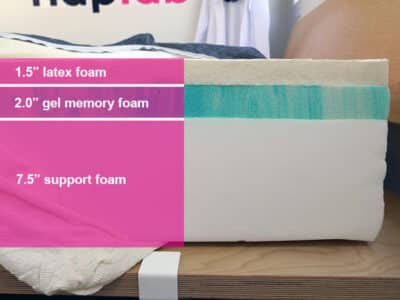
Best For
- Extremely fast material response time
- High levels of bounce, can be beneficial for sex performance
- Budget-friendly price point
Considerations
- Higher levels of motion transfer
- Edge support is good, but definitely not great
- 10″ thickness may not be suitable for heavier sleepers
Our Verdict
Performance for the Puffy Cloud is a bit of a mixed bag. Motion transfer was high and was by far the weakest area of Puffy. Cooling and edge support were both good, but far from great.
Even so, considering the fast response, excellent pressure relief, solid sex performance, and compelling price point, it’s still a mattress worth considering.
Puffy Cloud is the right choice when you love the feel of a more dramatic and exacting body contouring hug. The all foam design and modern memory foam feel create that comfort dynamic.
It’s also a good pick when you need to keep the budget in check. At $1,049 it’s not cheap, but it’s far from expensive. Based on the 170+ mattresses we’ve tested to date, we’ve seen far stronger performance and material quality from mattresses at or above the $1K price.
Type: Foam
Firmness: Medium-Firm (6)
Best For: All Sleeping Positions, All Body Weights
In This Review
Performance Tests | Firmness | Support & Sleeping Positions | Design | Materials | Comparisons | FAQs
Performance Tests
At NapLab, we put each mattress to the test.
We test 10 different factors that impact the performance, comfort, and value of the mattress. Testing categories include:
| Test | Rating |
|---|---|
| Cooling | Very Good |
| Sinkage | Moderate |
| Motion Transfer | High |
| Response Time | Extremely Fast |
| Bounce | High |
| Edge Support | Very Good |
| Sex | Excellent |
| Pressure Relief | Excellent |
| Off-Gassing | Excellent |
| Company | Excellent |
How is the Puffy Cloud Different?
The Puffy Cloud mattress has a performance score that is below average and a price that is slightly below average as well—10% less than the average foam mattress.

Advantages
The Puffy Cloud has a faster response time than the average by 0.2 seconds. It also has a higher sex performance score, thanks in large part to the higher levels of bounce.
Neutral Factors
Considering neutral factors, the Puffy Cloud has slightly less sinkage than average, a difference of 8%. It also has slightly more bounce as well with 11% more bounce than the average mattress (considering all types, not just foam mattresses).
Disadvantages
Cooling performance is below average by 0.4 of a point and motion transfer levels are also higher, measuring 45% more motion than average in our performance tests.
This higher level of motion transfer is largely a product of the thinner mattress profile. The Puffy Cloud is only a 10″ thick mattress whereas the average mattress thickness we see is 11.9″.
Edge support has 0.33″ more sinkage when seated at the edge of the mattress, which is deeper than the average, but not by a hugely noticeable amount.
| Factor | Puffy Cloud | Average |
|---|---|---|
| Overall | 9.36 | 9.51 |
| Price | $1,049 | $1,163 (Foam only) |
| Cooling | 9.0 | 9.4 |
| Max Sinkage | 2.02″ | 2.18″ |
| Total Motion Transfer | 11.99 m/s² | 8.27 m/s² |
| Response Time | 0.2 sec. | 0.4 sec. |
| Total Bounce | 10.69″ | 9.65″ |
| Edge Support – Sitting Sinkage | 4.50″ | 4.17″ |
| Mattress Thickness | 10.0″ | 11.9″ |
| Sex Overall | 9.8 | 9.6 |
| Comfort Material | 4.0″ | 4.2″ |
| Off-Gassing – Smell | Strong | Strong |
| Off-Gassing – Days | 6 days | 5 days |
| Trial | 101 nights | 162 nights |
| Warranty | Lifetime | 27% have lifetime warranties, average of other 73% of mattresses is 14 years |
Cooling Test
The Puffy Cloud has good, but not great cooling. During our tests, I felt a slight to moderate level of heat retention around my body.
Baseline Temp.
82.0° F
Max Temp.
90.5° F
Ending Temp.
85.7° F
While the all-foam design and memory foam create excellent pressure relief, it also isn’t able to breathe as well as a hybrid or coil mattress. As a result, we experienced a more noted level of heat retaining within the mattress.
Max Temp.

Ending Temp

- Baseline Temperature – the temperature of the mattress before anyone lies on it
- Maximum Temperature (0 minute) – the temperature of the mattress after lying on it for 15 minutes
- Ending Temperature (5 minute) – the temperature of the mattress after being lied upon and having no one on it for 5 minutes
In our objective temperature testing, we measured a max surface level temperature of 90.5°, which is 1.12° warmer than average.
After getting off the mattress the temperature declined by 3.3° from minutes 0 to 1, which is 1.24° warmer than average.
Heat Dissipation Over Time

From minutes 0 to 5 the decline was 4.8°, which is 2.1° warmer than average. In looking at our objective data we see a mattress that just isn’t able to release heat as quickly.
Sinkage Test
The Puffy Cloud has a moderate level of sinkage. In our pressure point sinkage tests, we measured a sinkage depth of 2.02”. This is 0.16” more sinkage than the average of 2.18”.
Sinkage Depth
2.02″
Sinkage Feel
Moderate
The level of sinkage is documented in the image below.

The Cloud mattress creates a dramatic body contouring hug. While the sinkage depth is more modest, the foam still wraps to your exact shape. This type of contouring hug creates fantastic pressure relief and is incredibly comfortable.
Motion Transfer Test
The Puffy Cloud has a high level of motion transfer. In our tests, we measured a total acceleration range of 11.99 m/s². This is 45.0% more motion than the average of 8.27 m/s².
Max. Acceleration
5.89 m/s²
Min. Acceleration
-6.10 m/s²
Accel. Range
11.99 m/s²
While the all-foam design and memory foam layers do help to absorb a good portion of energy, the thinner 10” profile just doesn’t seem to be thick enough to completely absorb the energy and motion.
The level of motion transfer is also documented in the video below.
In our motion transfer chart, which visualizes our accelerometer data, we see the highest motion from 0 to 0.14 seconds. There is a secondary more moderate energy spike (as the medicine ball makes its second bounce) from 0.42 to 0.57 seconds. By 0.85 seconds we return to near-zero levels of energy.

Mattresses with the lowest energy levels return to near zero within 0.3 seconds. Needless to say, Puffy Cloud isn’t quite at that level, though I was pleased to see the duration not exceed the 1-second mark.
Response Test
The Puffy Cloud has an extremely fast material response. In our tests, we measured a mostly recovered response time of 0.2 seconds and a fully recovered response time of 0.4 seconds.
Mostly Recovered
0.2 sec.
Complete Recovery
0.4 sec.
At these responsiveness speeds it is nearly tied with the fastest recovering mattresses we’ve tested to date.
Based on all of our tests to date, we have measured an average mostly recovered speed of 0.41 seconds and an average fully recovered speed of 0.84 seconds.
The level of responsiveness is documented in the video below.
Puffy appears to be using a more modern memory foam. The result is a foam that has the pressure relief, contour, and comfort of memory foam, but also rebounds back to shape nearly at the speed of latex. I expect most sleepers will be happy with the responsiveness of the Puffy.
Bounce Test
The Puffy Cloud has a high level of bounce. In our tests, we measured a total bounce height of 10.69”. This is 1.04” more bounce than the average of 9.65”.
Max. Depth
5.72″
Max. Rebound
4.97″
Total Bounce
10.69″
Ideally, I want to see bounce in the 8-12” range. At this level, the mattress is able to create easier movement and improve sex, while keeping motion in check.
Max. Sinkage Depth

Max Bounce Height

The level of bounce is also documented in the video below.
While we did measure a higher level of motion in our tests, the 10.69” bounce range does greatly improve ease of movement and is a significant factor in the strong sex performance (which we discuss 2 sections down).
Edge Support Test
The Puffy Cloud has good, but not great edge support for sitting and excellent edge support for lying.
Max Sinkage
4.50″
Lying Support
Excellent
In our sitting edge support tests, we measured a sitting sinkage compression of 4.5”. This is 0.33” more sitting compression than the average of 4.17”.
Ideally, I’m looking for 4.0” of sitting sinkage or less. Needless to say, Puffy Cloud didn’t hit that mark.
When sitting directly on the edge of the mattress I just don’t feel tremendously well supported. There is a significant compression of materials, which is especially notable given the mattress is only 10” thick.
The level of edge support while seated is documented in the images below.
Sitting, 140 lbs.

Sitting, 200 lbs.

While sitting support left something to be desired, I was pleased with the lying edge support. During our tests, I felt well-supported in all sleeping positions even when lying directly on the edge of the mattress.
The level of edge support while lying is documented in the images below.
Lying on Edge, 140 lbs.

Lying on Edge, 200 lbs.

The level of lying edge support is quite frankly, pretty surprising. Usually, 10” mattresses don’t do tremendously well with edge support, that’s even more true for all foam mattresses.
However, the foam quality here does seem notably above average. The higher quality foams help to maintain the shape and lying support better, even at the absolute edge.
Sex Test
The best mattresses for sex have high bounce, good edge support, quiet materials, and good pressure relief and cooling.
These 5 factors make up the NapLab sex performance score.
| Sex Factor | Factor Weight | Score | Rating |
|---|---|---|---|
| Bounce | 60% | 10 | High |
| Edge Support | 20% | 9.3 | Very Good |
| Noise | 10% | 10 | Minimal |
| Pressure Relief | 5% | 9.5 | Excellent |
| Cooling | 5% | 9.0 | Very Good |
For the Puffy Cloud, these individual factors generated a sex score of 9.8.
This mattress has very high levels of bounce and edge support that is good, but not great. Despite edge support falling short, the high levels of bounce are enough to really carry the sex score.

In addition, this mattress is quiet, has excellent pressure relief, and has very good cooling performance.
Pressure Relief Test
Pressure relief on Puffy Cloud is excellent. During our tests, I did not feel any significant level of pressure point build-up. The mattress was comfortable in all sleeping positions.
Comfort Layer
4.0″
Support Layer
6.0″
The Puffy Cloud has a simple, but proven all-foam design using a 4.0” comfort layer on top of 6.0” of support foam (same basic design as Ghostbed Classic, Leesa Original, and Casper Original).
Based on all of our tests to date, we see an average comfort layer thickness of 4.2”. Puffy Cloud is 0.2” less than average, but that’s not bad by any stretch.

Ideally, I like to see at least 4.0” of comfort foam and we get that with Puffy. The topmost 2.0” foam layer is more of a modern memory foam.
It creates a notable, exacting contouring hug, while still being responsive, reasonably cool, and non-heat reactive.
The core 2.0” is a more typical poly foam and doesn’t have the same type of memory foam feel.

As a result, it’s ideal for creating transitional support. My only concern is for heavier-weight sleepers.
This is less of an issue with Puffy Cloud specifically and more an issue with 10” mattresses in general.
Thinner mattresses typically struggle to provide support for heavier-weighted bodies.
As a result, I would urge caution for sleepers over 250 pounds. For heavier-weighted sleepers, the Puffy Royal or Puffy Lux would be a better choice.
Off-Gassing Test
Off-gassing odors were strong right out of the box and the smell lingered for 6 days.
Initial Smell Strength
Strong
Off-Gassing Period
6 days
This is longer than the average off-gassing period of 4.6 days, the average among all mattresses tested to date.
Company
The company score takes a look at factors that may influence your experience with the mattress.
Factors include length of the trial period, warranty, shipping / return costs, and country of origin.
| Company Factor | Factor Weight | Score | Data |
|---|---|---|---|
| Trial Period | 25% | 9.0 | 101 nights |
| Warranty | 25% | 10 | Lifetime |
| Shipping | 25% | 10 | $0 |
| Returns | 25% | 10 | $0 |
| Country of Origin | 0% | USA |
For Puffy, these individual terms and conditions generated a company score of 9.8.
Puffy offers a 101-night trial period and a lifetime warranty. Compared to the average, this trial is 38% shorter than the average, but the warranty is longer than average.
Shipping and returns are both free as well.
How firm is Puffy Cloud?
The Puffy Cloud mattress has a medium-firm feel with a firmness of 6 out of 10.

This firmness is suitable for a wide range of sleepers, being firm enough to support heavier sleepers, yet also soft enough to allow for sufficient pressure relief for lighter sleepers.
Support & Sleeping Positions
The Puffy Cloud has excellent support. In our tests, I felt well-supported in all sleeping positions.
The mattress checks most of the boxes I look for. At 10.0” thick the mattress isn’t quite as thick as the average of 11.9”.
As a result, it won’t be an ideal choice for heavier-weighted bodies (especially those over 250 pounds).
For lighter and moderate weighted bodies I expect the level of support will be perfectly sufficient.
The table below fully outlines what sleepers may be well suited for this mattress.
| Sleeper Weight | Stomach Sleepers | Side Sleepers | Back Sleepers |
|---|---|---|---|
| Under 150 lbs. | Yes | Yes | Yes |
| 150-250 lbs. | Yes | Yes | Yes |
| 250-300 lbs. | Maybe | Maybe | Maybe |
The fairly thick 4.0” comfort layer does a great job of reducing any potential pressure points. As a result, there won’t be any compounding support issues on the mattress.
Overall, I’m pleased with the level of support, especially given the price point.
Design
The Puffy Cloud is a 10″ thick foam mattress with a medium-firm feel (6 out of 10). It has a balanced feel and uses a blend of material types.
Type
Foam
Thickness
10″
Firmness
6

Materials
The Puffy Cloud mattress has three different foam layers. From top to bottom, these layers include:
- 2.0” poly foam (modern memory foam feel)
- 2.0” poly foam (transitional)
- 6.0” support foam

The Cover
The cover of the Puffy Cloud mattress is thin and zips off the mattress for cleaning. It is hypoallergenic and stain-resistant as well.

The Comfort Layer
The comfort layer is made up of two layers of poly foam. On the top layer is a 2.0″ poly foam (bright blue) that feels more like memory foam than traditional poly foam. It has viscoelastic properties that allow for a memory foam feel, but also fast material response times—truly the best of both worlds.

Below this layer is a second 2.0″ poly foam (light blue). The second layer acts more as a transitional layer with a denser feel. This layer allows sleepers to engage with the mattress as their weight transitions into the support layer below.
The goal of a good transitional layer is to limit pressure points and allow for sufficient support.
The Support Layer
The support layer at the base of the mattress is a 6.0″ high-density support foam.

This is a single-zoned support foam that lacks bells and whistles, but still provides sufficient support for a wide range of sleepers.
Product Evolution
The Puffy Cloud mattress was originally launched back in 2016. It has undergone minimal design changes since its initial release, if any, but in 2023 it was renamed the Puffy Cloud.
Aside from the name, there are no known material or design changes from the original Puffy compared to the Puffy Cloud today.

Other Mattresses to Consider
Not sure if the Puffy Cloud is the right pick for you? Check out these three other top-rated all-foam options to consider.
For A Better Value

Douglas
9.73 Overall Score
The Douglas mattress is a 10″ thick all-foam mattress that uses a blend of poly foam and support foam. Compared to the Puffy Cloud, Douglas offers better performance in many categories, but most specifically cooling, motion transfer, and better edge support. It’s also a fantastic value at only $749 for a queen mattress.
For Motion Transfer

Nest Bedding Quail
9.59 Overall Score
The Nest Bedding Quail is another 10″ foam mattress that uses a blend of poly foam and support foam. This mattress has a 3.0″ top layer that helps improve pressure relief as well as limit high levels of motion transfer. The Quail is available in two firmness levels—medium (5) and firm (8). The only downside to the Nest Bedding Quail is worse edge support, but that may or may not be a deal-breaker for all sleepers.
For A Different Feel

GhostBed Classic
9.53 Overall Score
The GhostBed Classic is an 11″ thick that uses latex foam and memory foam for the comfort layers, a different approach than the poly foam we noted on the Puffy Cloud. The latex top layer creates a more generalized hug around the body, while the memory foam core provides deep compression sinkage, sharper contouring, and support.
Frequently Asked Questions
Still have questions? Check out some of the top FAQs on the Puffy Cloud mattress below and get the answers you’re looking for.
Here are the current prices, with any sales or promotions reflected below:
Twin: $599
Twin XL: $749
Full: $899
Queen: $1,049
King: $1,249
Cal. King: $1,249
Split King: $1,498
*Note: Sales prices are subject to change without notice or warning.



